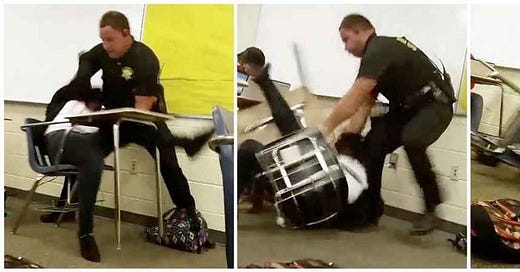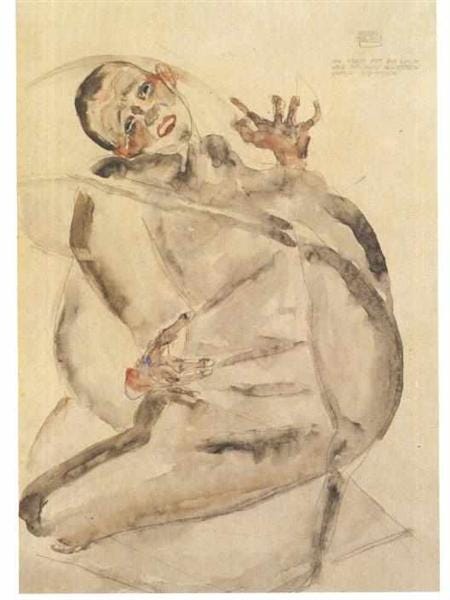Disturbing schools
A federal judge just closed a pipeline for criminalizing kids in South Carolina
Niya Kenny was in math class when she saw a cop pick a classmate up by the neck, flip her desk, and throw her to the ground. Niya recorded the whole incident on her phone and shouted for someone to intervene.
Niya and her classmate were both arrested that day in October 2015 at Spring Valley High School in Columbia, S.C. Police charged them both with “disturbing schools” under a catch-all law that the state of South Carolina used to criminalize children — especially Black children — for decades.
Niya became a lead plaintiff in Kenny v. Wilson, a lawsuit that challenged the disturbing schools law as unconstitutionally vague.1 She won a major victory on Friday.
U.S. District Judge Margaret B. Seymour ordered the state of South Carolina on Oct. 8 to stop retaining records of disturbing-schools violations and to stop enforcing a similarly vague law against “disorderly conduct” in K-12 schools. She upheld a lower court opinion that the disturbing schools law was unconstitutionally vague and discriminatory in its application.
I want to highlight Judge Seymour’s opinion this week, not only because it marks a decisive victory for the people of South Carolina, but because it specifically smacked down the feeble-minded arguments of the defendant in Kenny v. Wilson, South Carolina Attorney General Alan Wilson.
Seymour, a Clinton appointee, writes in the opinion:
The undisputed record demonstrates that the absence of objective criteria has in fact led to discriminatory enforcement of the Law. Specifically, the subjectivity governing the decision-making process of who should be charged and under what circumstances has led to a disproportionate number of Black students and students with disabilities entering the juvenile justice system … The undisputed record further demonstrates that contact with the juvenile justice system increases the risk that a young person will drop out of school and that he or she may be incarcerated later in life.
I’ve been following this case since 2015, when I was an education reporter at the largest daily newspaper in South Carolina. My colleague Deanna Pan and I wrote a series of articles explaining the disturbing schools law as a key component of the school-to-prison pipeline. Since around the turn of the millennium, the law had hovered around No. 1 and No. 2 on the list of most common referrals to the S.C. Department of Juvenile Justice. We found cases of children as young as 9 being charged under the law.
“All we see is what comes in, and you can sit in any of our courtrooms any day and it's black child after black child,” Charleston County juvenile public defender Tamara Coppinger said at the time.
One fact we learned was that the disturbing schools law wasn’t always applied to students. Originally enacted in 1919, the law originally only applied to all-girls schools and was meant to keep trespassers off campus. I wrote in 2015:
It remains unclear when police began applying the law to students, but by 1994 the state had endorsed its use as such. That year, a Jasper County School District official wrote to then-Attorney General Travis Medlock asking whether police could arrest students if they fought on campus, refused to leave campus when asked by a principal, or used profane language toward police or a principal.
Medlock wrote back that all three offenses could be considered disturbing school.
“If these laws are used forcefully, firmly and fearlessly, they will greatly help to make schools the safe zones we need,” Medlock wrote.
The widespread application of the disturbing schools law to South Carolina students in the 1990s came about as schools began bringing in school resource officers to patrol the halls, guard against terrorist threats and — increasingly — intervene in student behavior issues.
The ranks of school resource officers swelled nationwide after the 1999 Columbine High shooting, and by 2002, disturbing schools was the most common reason for Juvenile Justice referrals in South Carolina.
The Oct. 8 District Court decision tallies up some grim statistics about Disturbing Schools and its successor, Disorderly Conduct, which schools and police began applying more broadly when Disturbing Schools was taken off the table as a potential charge for students.
Between August 2010 and March 2016 alone, the judge wrote, more than 9,500 adolescents entered the juvenile justice system on charges of disturbing schools. Between August 2015 and July 2020, police received 5,120 referrals of youth for disorderly conduct. 75% of those referrals were for Black youth, who comprised only 30% of the youth population.
Those are only statistics. Kenny and the other plaintiffs’ testimonies brought to light the secretive, Kafkaesque system of juvenile justice they had to navigate. One plaintiff, a Dorchester County student identified as D.S., faced jail time over a fight in a school hallway and couldn’t afford the $450 fees to participate in pre-trial intervention. S.P., a 15-year-old student from Greenville County, got into a verbal argument with another student in the school library and had the principal tell her, “I could arrest you for not coming with me.” She was charged with disorderly conduct, and she and her mother couldn’t afford the $40 application fee for a public defender.
D.D., a Black male student from the Myrtle Beach area, got charged with disturbing schools after an unidentified student at his middle school posted on social media that D.D. was going to shoot up a school. D.D. and his family never got to see the social media posts in question. He was sent to an alternative school with a criminal charge hanging over his head. He started losing sleep and stopped talking to people.
“I look at the stuff on the internet regarding the incident because I’m all over the internet and I cry about it,” D.D. said. “[S]ome weeks I am OK and other weeks the depression hits hard and I do not want to talk to anyone.”
Faced with overwhelming evidence that the state’s child criminal laws were vague in their wording and openly racist in their application, South Carolina’s attorney general put up a shameful defense of the status quo. At various points as the case wended its way through the courts, Attorney General Alan Wilson’s office tried to argue that the plaintiffs’ claims became moot when they graduated and dug up some cases where the law was appropriately enforced “to criminalize disruptive behavior.”
Judge Seymour swatted away Wilson’s arguments, opining, “This degree of unpredictability is not compatible with the protections afforded by due process.”
The function of the criminal justice system that terrorized Niya Kenny, D.S., S.P., and D.D. is not to keep schools safe. It is certainly not to rehabilitate children with behavioral problems. Its function is to render them criminals.
When I say “function,” I don’t mean “intent.” The intent of individual lawmakers, cops, family court judges, and prosecutors is unknowable. But the function is right out in the open. If South Carolina were a country, it — like most U.S. states — would have a higher incarceration rate than any country on earth, according to the Prison Policy Initiative.
The Disturbing Schools and Disorderly Conduct laws fed children into that system by the thousands. The damage is already done, and it spans multiple generations. At least we can say this particular pipeline is shut.
***
The Oct. 8 order in Kenny v. Wilson is available to read on the ACLU of South Carolina website. Here’s something I wrote about Alan Wilson back in 2020 that I still stand by:
Elsewhere on the internet this week, Chelsea Grinstead at the Charleston City Paper was kind enough to run a story on the new album Words Are Fragile Vessels by my band, The Camellias. You can read the story here and listen to the album for free on Bandcamp.
This week I’ve been reading the Gospel of Luke and Necropolitics by Achille Mbembe. Mbembe’s book is a devastating, essential read on the rot and enmity at the core of 21st-century disaster capitalism. It also contains this lovely prophetic passage in the first chapter, which has been good food for thought as I continue to ponder the questions of who is my neighbor and who is my enemy:
In several regards, the question that we raised yesterday is exactly the same one that we must raise anew today. This is the question of knowing if it was ever possible, if it is possible, and if it will ever be possible, for us to encounter the other differently than as a given object, one that is simply there, at arm’s length. Can there be anything that links us to others with whom we declare that we are together? What forms might this solicitude take? Is another politics of the world possible, a politics that no longer necessarily rests upon difference or alterity but instead on a certain idea of the kindred and the in-common? Are we not condemned to live in our exposure to one another, sometimes in the same space?
Thanks for reading. Brutal South is a free weekly newsletter and occasional podcast focused on education, culture, and class struggle in the American South. If you would like to support my work and get access to some exclusive content as well as some rad Brutal South logo stickers, consider becoming a paid subscriber ($5/month).
If you can’t afford that, please just share this with your friends. The only way I reach new readers is by word of mouth.
Twitter // Bookshop // Bandcamp // Apple Podcasts // Spotify Podcasts
Kenny, her fellow plaintiffs, and the ACLU of South Carolina previously won a major victory before the Fourth Circuit Court of Appeals in 2018, leading the state to drop enforcement of the disturbing schools law against students. At the time of Kenny’s arrest, disturbing schools was a misdemeanor charge that punished anyone behaving in “an obnoxious manner” at a school. It carried a maximum $1,000 fine and 90-day jail sentence. The law (South Carolina Code 16-17-420) is still on the books but has been revised so that it no longer applies to students.







👏👏👏